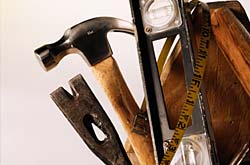Look for Value and Need with Your Home Improvement Budget
See if We Have Top-Rated
Home Improvement Professionals in Your Area

Many homeowners may wonder which area of their home is the best place to spend dollars on. One way to decide how to spend your home improvement budget is to take a page from the playbook of NFL teams, who look for both value and need, when drafting new players each year.
Home Improvements with the Best Value
Of course, what exactly one means by "value" needs to be addressed. The measure of various projects' resale value (increase in property value), personal enjoyment (day-to-day convenience or weekly recreation), and simple cost-effectiveness can be very different. In terms of resale value, a wood deck is among the top home improvements, recovering, on average, 81.8 percent of its initial cost in additional property value, according to Remodeling Magazine's Cost vs. Value Report. To this extent, location is paramount, as it is with all value and need calculations. In the Pacific region of the U.S., a new wood deck averages a resale value of 97.1 percent of its cost, whereas in the industrial Midwest, the same deck will add only about 68.9 percent of its value.
The value of a project's personal enjoyment is perhaps the easiest to understand, if the most difficult define and measure. Everything from home office furniture to a whirlpool bathtub, home theater system to house painting can fit this bill.
Cost-effectiveness can take many forms—a quality metal roof might deliver 30-50 years of virtually maintenance-free, energy-efficient shelter for what amounts to just a few hundred dollars a year. Often, the most cost-effective home improvements require a larger upfront investment, but the most practical and valuable projects tend to center on energy-efficiency and reducing your utility bills. Depending on the current condition of your windows, doors, insulation, appliances and heating/cooling systems, an upgrade may pay for itself in about 10-15 years and, possibly, as soon as 5 years. Generally speaking, if you haven't completed any energy-efficient upgrades recently, one of these gems is probably waiting for your attention and will entitle you to a tax credit of up to $1,500.
Home Improvements that Fill a Need
Given the life expectancy of most modern appliances is only 7-10 years and the number of appliances in the contemporary home, a new appliance is the most common need. If you own a pet, especially a dog, a handful of home improvements such as hard-surface flooring and outdoor containment fencing could be classified as a need. Storage is also a common home improvement need and can be incorporated by anything from cabinet installation, closet or garage organizers, or a larger project such as a basement remodel.
In one way, a home inspection is the first and last need for any homeowner. To responsibly determine and inform a prospective home buyer of any defects a home might have, home inspections are a critical piece of maintenance for these transactions. Most states have some form of legal obligation to identify certain home defects, so the property may actually revert to the original owner in some cases. Regardless, home inspections are a great, underutilized asset that can serve more functions than just housing sales. If you're unsure about what area of your home has the greatest renovation needs, hiring a home inspector is a great way to make this determination.
Look for Opportunities to Trade Up or Down
Another way to put this might be to start big and scale back your plans, or to start with a small project and see what else a contractor recommends. You might, for example, hire a carpenter to fix a loose railing for a staircase and ask about the cost for other small projects, such as installing decorative paneling or trim, small custom-built shelves, window shutters, or any other basic wood-working project you can imagine. Alternately, you might solicit bids for a deck installation your neighbor said cost $12,000 in the hopes you can find a contractor or deck design that will allow you to stay within a $10,000 budget. At the same time, there is no reason to feel you have to make a decision until you've solicited estimates from multiple contractors and/or multiple projects. The answer may become clear when you're able to compare the "nuts-and-bolts" costs of each project.
More Tips & Advice For Your Home
- Related Articles
- Recent Articles

